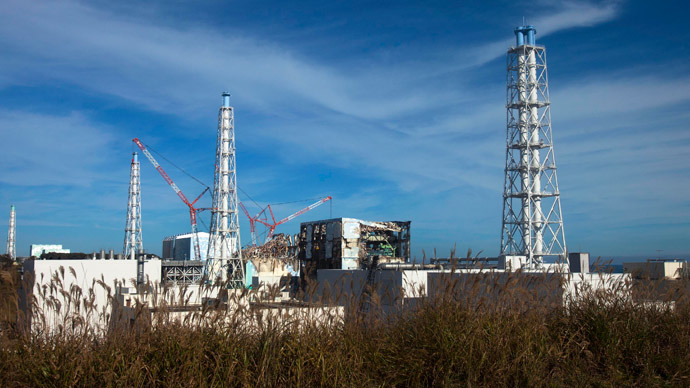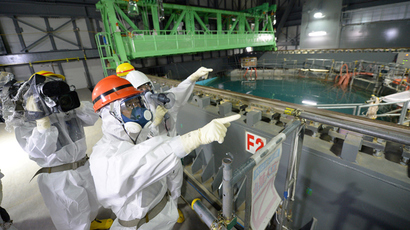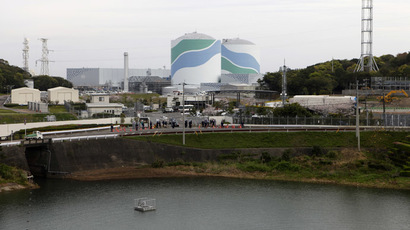Only 26-meter tsunami could now damage Fukushima – TEPCO

The operator of Japan's crippled Fukushima nuclear plant has raised the tsunami projectile height, saying it would take a 26-meter wave to damage the facility and cause radioactive leakage, local media reported. This comes as Japan faces a typhoon threat.
Officials from the Tokyo Electric Power Company (TEPCO) have
nearly doubled the previous projected tsunami height that would
inundate the Fukushima Daiichi nuclear plant – raising it from 14
to 26.3 meters, Asahi Shimbun reported on Saturday.
The flood caused by such a tsunami would “likely cause
seawater to mingle with the radiation-tainted water accumulating
in the basements of the reactor buildings at the six-unit plant,
allowing 100 trillion becquerels of cesium to escape,” The
Japan Times reported, citing TEPCO officials.
However, TEPCO officials noted that such a strong tsunami occurs
only once every 10,000 to 100,000 years.
The operator also increased the scale of a potential earthquake
that would damage the plant by 1.5 times to 900 gals, media
reported.
The company’s statement made on Friday comes in response to a
demand made by Japan’s Nuclear Regulation Authority (NRA) for the
operator to review tsunami counter-measures. The authority is to
decide whether TEPCO’s figures are suitable.
Following the March 2011 earthquake that triggered a 15.5 meter
tsunami and hit the Fukushima Daiichi plant – causing three
nuclear core meltdowns – the NRA obliged other facilities to
strengthen tsunami counter-measures and raise the scale of the
highest tsunami protection. But the new regulation did not apply
to Fukushima, which is over 40 years old, as the plant was to be
decommissioned.
As a measure to reduce the impact of a potential hit by a huge
seismic wave, TEPCO said it will cut the quantity of radioactive
water stored on the premises of the facility. Thus, the amount of
radioactive water leaked into the ocean would be reduced by 30
percent, Asahi reported.
In the wake of the 2011 tragedy, Japan shut down all its nuclear
reactors. However, the Japanese government has been keen on the
nuclear restart, insisting that the reactors are necessary to
provide cheaper energy to the economically-challenged Asian
nation.

On September 10, the NRA cleared the Sendai facility in Kagoshima
prefecture to be restarted, causing a stir across the globe.
Critics of the decision have pointed to the threat posed by a
volcano located nearby. Its eruption in September killed over 30
people and injured dozens.
READ MORE: Eruption or not, nuclear restart in
Japan to go ahead on schedule
Will Typhoon Phanfone affect Fukushima?
At the same time, Japan is preparing for a powerful and dangerous typhoon heading for its shores. Forecasts made by Japanese meteorologists indicate that Typhoon Phanfone will hit the main islands of the country late on Sunday.
As the eye of the storm passed the southern Japanese islands of Okinawa, three men were washed away by the storm. One US airman was confirmed dead while two more are still missing, having disappeared into the sea from Kandena Air Base on Sunday.
Typhoon #Phanfone nearing Japan, heavy rain underway. Japanese Radar: http://t.co/lLPF5CbgtI Animated GIF: http://t.co/HDj8jIvAg5
— Eric Holthaus (@EricHolthaus) October 5, 2014
Super Typhoon Phanfone http://t.co/x3KrCDwEWB#NASApic.twitter.com/ZoF1kq2EVh
— NASA Earth (@NASA_EO) October 4, 2014
“Phanfone will be steadily weakening as it approaches Japan, and should be no stronger than a Category 1 storm at its point of closest approach,” meteorologist Jeff Masters wrote on the blog 'Weather Underground.'
Typhoon Phanfone Lashing Japan http://t.co/uvBOSBpx4opic.twitter.com/YHVjyX99nD
— Tokyo Reporter (@tokyoreporter) October 5, 2014
The typhoon has sparked lively debate on Twitter, in terms of how it will affect the crippled Fukushima nuclear plant.
Typhoon Phanfong will be another big setback for Fukushima nuke plant cleanup efforts,& a second storm coming http://t.co/29xYGeap2E
— NC StockGuy (@NCStockGuy) October 3, 2014
Next the still crippled Fukushima plant get's hit by a Typhoon. Good luck with that new sea wall... #Tepco#Japanhttp://t.co/AwhF5GIqgj
— Anthony Allyn (@3Xtraders) October 3, 2014
A previous typhoon which swept through Japan last October led to
highly radioactive water near the nuclear plant being released
into a nearby drainage ditch, increasing the risk of it flowing
into the sea.
READ MORE: Toxic flush: Typhoon causes radioactive leaks at Fukushima














